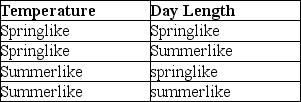The following experiment is used for the following question.
A researcher discovered a species of moth that lays its eggs on oak trees. Eggs are laid at two distinct times of the year: early in spring when the oak trees are flowering and in midsummer when flowering is past. Caterpillars from eggs that hatch in spring feed on oak flowers and look like oak flowers, but caterpillars that hatch in summer feed on oak leaves and look like oak twigs.
How does the same population of moths produce such different-looking caterpillars on the same trees? To answer this question, the biologist caught many female moths from the same population and collected their eggs. He put at least one egg from each female into eight identical cups. The eggs hatched, and at least two larvae from each female were maintained in one of the four temperature and light conditions listed below.
In each of the four environments, one of the caterpillars was fed oak flowers, the other oak leaves. Thus, there were a total of eight treatment groups (4 environments × 2 diets) .
In every case, caterpillars that feed on oak flowers look like oak flowers. In every case, caterpillars that were raised on oak leaves looked like twigs. These results support which of the following hypotheses?
Definitions:
Republicanism
A political ideology centered on citizenship in a state organized as a republic under which the people hold popular sovereignty.
Political Advantages
The benefits or leverage that a person, party, or state acquires which can be used to influence political outcomes or gain power.
Battle at Brandywine
A major battle between American troops led by George Washington and British forces during the American Revolutionary War on September 11, 1777.
Q1: Backward invention occurs when a firm _.<br>A)
Q10: One of the buffers that contribute to
Q15: Use the following information to answer the
Q16: Pepe Homes manufactures a range of bathroom
Q17: A company that is planning to go
Q26: The enzyme amylase can break glycosidic linkages
Q30: Organic molecules with only hydrogens and five
Q30: The following experiment is used for the
Q54: If one strand of a DNA molecule
Q56: <img src="https://d2lvgg3v3hfg70.cloudfront.net/TB1096/.jpg" alt=" Based on Figure